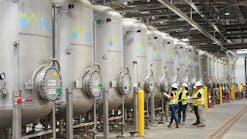By Cheri D. Cohen
When its brush rotor system failed, the city of Franklin, LA, decided to replace it with an Aire-O2 Triton® aeration/mixer system, which about equaled the ongoing costs of refurbishing the rotors. The aerators met all the city's needs and a year later, city officials purchased more of the aerators for its second ditch.
Back in 2000, Franklin's wastewater treatment plant consisted of an activated sludge system in two parallel concrete oxidation ovals that relied on brush rotors for aeration. Two brush rotors were used in each ditch. The plant receives a total flow of 2.4 mgd that splits between the two ovals for treatment. Boat clarifiers are located in each oxidation oval. The size of each ditch is 688 ft x 23 ft x 11 ft.
The city's discharge limits are very strict. BOD and TSS effluent values must be less than 15 mg/l and 23 mg/l (daily maximum), respectively. Aeration treatment performance and dependability is important to achieve these objectives.
The rotors had ongoing maintenance problems, according to John Ford, plant operator at the Franklin facility.
"We had so much trouble with the bearings. We had to go out and grease them every day and even on Saturdays. And, that was even following the advice of the manufacturers' recommendation," he said.
Eventually, the equipment started failing.
"The rotor broke in the middle, we lost a lot of manpower hours, and maintenance became very difficult and kind of dangerous," Ford said.
The decision was made to replace the failed rotor system with a new aeration system in early 2000. John C. Fore, Jr., P.E., of Miller Engineers & Associates, located in Franklin, was the project manager.
"There were two main things we were looking for in a new aeration system," Fore said. "It had to put enough dissolved oxygen into the ditch. And, it had to maintain a certain velocity."
Mixing to maintain velocity is important for the oval's boat clarifier to operate efficiently. A rate of 1.0 fps to 1.3 fps in the channel for proper velocity of 0.7 to 1.0 fps at the boat clarifier was required.
The Aire-O2 Triton® aeration/ mixer system was selected to replace the rotors in Ditch #2. Four 25 hp aerator/mixers were mounted on floats in sets of two strategically placed in the ditch to allow for optimal mixing and treatment efficiencies.
The aerators are manufactured by Aeration Industries International of Chaska, MN. The Aire-O2 Triton® aerator/mixer is an electric motor-driven air assist propeller-type floating aerator equipped with a regenerative blower. The aerator's primary and secondary propellers inject air in a high velocity stream of bubbles, defined by the Environmental Protection Agency (EPA) as "fine bubble," below the surface of the water and provide flow-linkage mixing in multiple unit arrangements.
Mixing Velocity Tests
At the request of the city, velocity testing was performed by United Industries Inc. on Ditch #2 in August 2000 to ensure that the new aerators were providing the proper water velocity.
Velocity tests were conducted on both ditches having the brush rotors (Ditch #1) and the Triton aerators (Ditch #2). Data for Ditch #1 was less complete since it still used the brush rotors. The flows were measured there for comparison.
The United Industries report states, "The velocity readings of over 1 ft/sec in the vicinity of the clarifier indicate that no deposits are expected to develop here and that the clarifier should function. Inspection seems to indicate that the velocity readings in Ditch #2 (the Triton aerators) tend to be higher than in Ditch #1 (the brush rotors)." The full report is available upon request.
It should be noted that the United Industries report does state that the tests were performed only on one day at a particular time and configuration. However, the ultimate aeration performance test is making permit limits. According to the project engineer, the Triton system passed those criteria.
In an October 2000 correspondence, Fore made the following observations:
"The Triton aerators have been giving flows in the area we expect since installation because the effluent has been satisfactory." In addition, "only three of the four units are required to provide the desired DO (dissolved oxygen) in the ditch."
In May 2001, the city of Franklin decided to replace the brush rotor system in Ditch #1 with another Triton aerator/mixer system that also included four 25 hp units.




